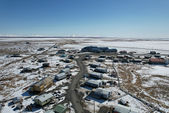Designing Resilience:Housing Prototype for Quinhagak, Alaska, 2024
Pratt Institute, Brooklyn

During the academic year 2024-25 at Pratt Institute, I have the opportunity to collaborate with a multidisciplinary team on a meaningful project addressing climate change adaptation for the Yup’ik community in Quinhagak, Alaska. This project is being developed under the insightful guidance of Professors Enrique Lanz Oca and Natalie Monterrosa, in collaboration with talented architects and design colleagues.
The project is an experimental prototype designed to tackle the severe environmental challenges faced by the community. Using locally available resources to ensure the project’s viability and considering the challenges and costs of shipment to remote areas, it integrates a sustainable housing unit with renewable energy systems, including micro-wind turbines, solar panels, and an energy storage center. Most importantly, it prioritizes the educational and cultural aspects that are vital to the community’s resilience.
The Arctic tundra is undergoing rapid environmental changes, from sea-ice decline to permafrost thawing and rising sea levels, which threaten the livelihoods of indigenous communities. The goal of this project is to work closely with the community to create adaptive strategies that honor the cultural traditions of the Yup’ik people while supporting their resilience against these challenges, sharing knowledge while ensuring the community’s autonomy and decision-making power remain intact.
The work and my perspective are rooted in humility—understanding needs, respecting autonomy, and learning from ancestral wisdom. It reaffirms my belief that design is not about imposing futures but about empowering communities to envision their own, while we learn from them how to sustain ours.
Growing up surrounded by cultural richness and maintaining connections with indigenous communities in Xingu, I’ve always been inspired by how communities make the most of and learn from their environments. The lack of this connection is one of the main reasons we face a climate crisis today. I am fascinated by ancestral technologies that can help solve contemporary problems. This project has provided an opportunity to bring that perspective into a global context and to learn so much more about ways of living in extreme conditions that, while different from those I am familiar with in Brazil, share similar challenges shaped by climate.
This experience strengthens my commitment to sustainability, cultural sensitivity, and the role of design in addressing global challenges. It has been a privilege to contribute to this work, to learn from others, and to share perspectives. I look forward to another semester collaborating with this team.


